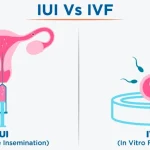How IVF Gender Selection Works for a Male Baby
How to Get a Male Child Through IVF? It’s a question many couples ask when they begin exploring fertility treatments. Thanks to advancements in reproductive medicine, it’s now possible to select the sex of a baby through in vitro fertilization (IVF) combined with specialized techniques like genetic testing. While the idea of “choosing” your baby’s gender may sound futuristic, it’s a reality in clinics around the world today.
This guide explains how gender selection works in IVF, the science behind choosing a male child, the success rates, ethical considerations, and what intending parents should know before pursuing this option.
Understanding IVF and Gender Selection

IVF, or in vitro fertilization, is a process where eggs are retrieved from the ovaries, fertilized with sperm in a lab, and then transferred back into the uterus. Typically, the main goal of IVF is to help couples who struggle with infertility conceive. However, modern reproductive technology has introduced another possibility — the ability to determine an embryo’s sex before implantation.
This is possible through Preimplantation Genetic Testing (PGT-A or PGT-M). These tests allow doctors to examine the DNA of embryos and determine whether they are genetically male (XY chromosomes) or female (XX chromosomes). By doing this, doctors can identify which embryos are male and transfer them, giving parents the opportunity to have a boy if that is their goal.
How Gender Selection Works in IVF
The process of selecting a male child through IVF is more complex than a natural pregnancy, but follows a systematic path.
First, the mother undergoes ovarian stimulation, where fertility medications encourage her ovaries to produce multiple eggs. Once the eggs are mature, they are collected in a minor surgical procedure called egg retrieval. These eggs are then fertilized with sperm in a laboratory setting to create embryos.
After several days of growth, the embryos reach the blastocyst stage, usually around day five. At this point, doctors perform a small biopsy, removing a few cells from each embryo. These cells are tested to determine both the health of the embryo and its sex chromosomes. If the goal is to have a male child, the clinic selects a healthy XY embryo.
Finally, the chosen embryo is transferred into the uterus, where it may implant and grow into a pregnancy. This method provides near certainty in selecting the sex of a child, something natural conception cannot offer.
Why Do Parents Choose IVF for a Male Child?
There are many reasons why families may choose IVF for gender selection, and these reasons are often deeply personal.
For some, the motivation is family balancing. Couples who already have daughters may wish to complete their family with a son, or vice versa. For others, the decision is rooted in medical necessity. Certain genetic disorders are linked to sex chromosomes and are more common in males. By choosing a male or female embryo, parents can avoid passing down a genetic condition.
Cultural and social values also play a role. In some cultures, there is a strong desire for male children due to traditions, inheritance, or family lineage. Although this is more controversial, it remains a common factor for couples seeking gender selection.
Ultimately, whether the reason is emotional, cultural, or medical, IVF provides a safe and effective way to achieve this outcome.
Success Rates of Male Child Selection with IVF
The success of choosing a male child through IVF depends on two main factors: the accuracy of the genetic testing and the success of the IVF procedure itself.
Genetic testing, such as PGT-A, is over 99% accurate at identifying the sex of an embryo. This means that if you choose a male embryo for transfer, the chances of having a boy are nearly guaranteed. However, achieving a successful pregnancy is not guaranteed. Implantation rates depend on the health of the embryo, the age of the mother, and overall fertility health.
For example, younger women with healthy eggs often see higher success rates because their embryos are more viable. Older women may have fewer embryos available for testing, which can limit options for gender selection. Nonetheless, when a healthy male embryo is transferred, the likelihood of achieving the desired outcome is extremely high.
IVF Sperm Sorting vs Genetic Testing
Some clinics also offer sperm sorting methods as an alternative to genetic testing. In this process, sperm carrying the X chromosome (which leads to a female embryo) and sperm carrying the Y chromosome (which leads to a male embryo) are separated before fertilization.
While sperm sorting increases the chances of producing a male embryo, it is not as precise as genetic testing. Accuracy rates vary, often around 70–80%, compared to the near-certainty of PGT-A testing. Moreover, sperm sorting does not allow doctors to check for genetic abnormalities, which PGT-A can detect.
For couples who specifically want a male child, IVF with embryo genetic testing remains the most effective and reliable option.
Ethical Considerations in Gender Selection
The possibility of choosing a baby’s gender brings up ethical debates worldwide. Critics argue that allowing parents to choose could lead to gender imbalance, especially in cultures where male children are preferred. This could have long-term social consequences.
Others worry about the concept of “designer babies.” If we start choosing sex, will parents soon want to select traits like intelligence, height, or appearance? These questions spark serious discussions in medical and ethical communities.
Because of these concerns, some countries regulate or ban non-medical gender selection altogether. In countries where it is allowed, clinics often offer counselling services to ensure parents fully understand the implications.
The IVF Process Timeline for Gender Selection
When gender selection is added, the IVF timeline becomes slightly longer but still manageable.
The first stage involves ovarian stimulation, which usually takes 10–14 days. After this, eggs are retrieved and fertilized. Within 5–6 days, the embryos are ready for biopsy and genetic testing. Results are available within 1–2 weeks, at which point doctors can confirm which embryos are male and healthy.
In the next cycle, the chosen male embryo is transferred into the uterus. From the beginning to pregnancy test, the entire process can take 6–8 weeks per cycle.
Costs of Male Child Selection via IVF
The financial cost of gender selection is significant. A standard IVF cycle in Nigeria can cost between ₦18,000,000 and ₦22,500,000 (equivalent to $12,000–$15,000). If families choose to add PGT-A genetic testing, the cost typically increases by ₦6,000,000 to ₦10,500,000 ($4,000–$7,000).
Additionally, fertility medications may add another ₦4,500,000 to ₦7,500,000 ($3,000–$5,000).
Altogether, families pursuing IVF with gender selection can expect to spend between ₦27,000,000 and ₦37,500,000 per cycle. This is a major financial investment, so it’s important for couples to carefully weigh these costs alongside the emotional and physical demands of the IVF process.
Risks and Considerations

While IVF with gender selection is generally safe, there are still risks. Fertility medications may cause side effects such as bloating, headaches, or mood swings. Egg retrieval carries a small risk of infection or bleeding. There’s also the emotional toll of undergoing multiple cycles if pregnancy does not occur on the first attempt.
Another factor to consider is the limited number of embryos available. In some cases, only a small percentage of embryos may be male and healthy, which could reduce the chance of success in a single cycle.
What to Ask Your Doctor About IVF Gender Selection
Before moving forward, couples should have an open conversation with their fertility doctor. Important questions include:
● What is the clinic’s success rate for IVF with PGT-A?
● How many embryos should we expect for testing?
● Are there local laws or restrictions on gender selection?
● What are the risks in my specific case?
● How much will the entire process cost from start to finish?
By asking these questions, couples can make informed decisions and prepare realistically for the journey ahead.
Final Thoughts: Is IVF the Right Path to a Male Child?
So, how to get a male child through IVF? The answer lies in embryo genetic testing, which allows clinics to identify male embryos with near-perfect accuracy. While sperm sorting is another option, it cannot match the reliability of PGT-A.
For families seeking gender selection for medical reasons, family balancing, or personal preference, IVF offers a clear and scientifically proven pathway. However, it’s important to also consider the emotional, ethical, and financial aspects before making a decision. If you’re considering gender selection as part of your IVF journey, schedule a consultation with The Bridge Clinic today. Our team of fertility experts will walk you through the IVF process, explain your options, and help you make the best decision for your family’s future.
Follow us on our social media channels below:
Explore our related articles below:








